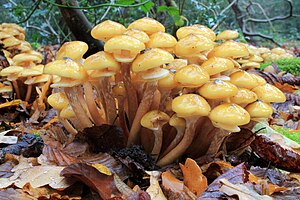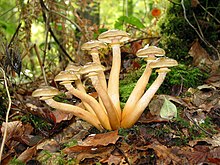Honey yellow honey mushroom
| Honey yellow honey mushroom | ||||||||||||
|---|---|---|---|---|---|---|---|---|---|---|---|---|

Honey yellow honey mushroom ( Armillaria mellea ) |
||||||||||||
| Systematics | ||||||||||||
|
||||||||||||
| Scientific name | ||||||||||||
| Armillaria mellea | ||||||||||||
| ( Vahl : Fr. ) P. Kumm. s. st. |
The honey yellow honey mushroom ( Armillaria mellea ), also called golden yellow honey mushroom or stuppling , is a type of mushroom from the family Physalacriaceae. Since it mostly appears around September 28th, the name day of Wenceslas , it is also known as Wenceslas mushroom in some areas . In the Austrian Alpine regions it was called Halamarsch or Halawatsch and is said to have been used as a remedy for hemorrhoids .
features
Macroscopic features
The hat becomes 4 to 10, sometimes up to 14 cm wide. It is initially frustoconical or hemispherical-convex, later flattened convex to indented. It is usually clearly tinted yellow, with the color ranging from honey , ocher to olive yellow. More rarely it is lemon yellow or brownish in color. The edge is rolled up in young fruiting bodies, being connected to the stalk by the velum partiale . On the matt and dry surface there are fine, dark, close-fitting to slightly erect hat scales that contrast with the ground and are clearly set off in the middle. They can be wiped off and are often washed away by the rain. The lamellae are initially creamy-white, later in a light brownish color and develop red-brown spots. They are more or less broad on the stem and run down with one line. The cutting edges are wavy to weakly notched. The spore powder is whitish. The stem is 4 to 10, sometimes up to 17 cm long and 5 to 15 mm thick. Above the ring it is whitish-flesh-colored, longitudinally grooved to longitudinally fibrous and underneath it is brownish with a flesh-colored tone and longitudinally fibrous. Towards the base, the stem has a yellow tone. Because of its tufted growth it is often curved. It is pointed at the base and bundled with other stems to form a pseudo-root. Sometimes the stem is slightly thickened at the base. Its consistency is elastic and tough. The whitish ring is membranous and has radial fibers. It is consistent and sits very high on the stick. There are mostly yellowish flakes on its outside. The meat is whitish in color and has a flesh-colored tone. It smells a bit musty and tastes mild. After prolonged chewing, the throat scratches.
Microscopic features
The broadly elliptical spores are 7–8.5 × 5.5–6.5 µm in size. The ratio between length and width is 1.2–1.5. They are hyaline and inamyloid . Their surface is smooth. The basidia have a slender club shape and are 30–40 × 6–9 µm in size. They each have four spores. There is no buckle on the base. The marginal cells are usually cylindrical to club-shaped and often have finger-shaped, gnarled outgrowths at the tip. Together they are 20-25 × 6-10 µm in size. The top layer of the hat consists of parallel, lying to rising hyphae . They are 7–15 µm wide and pigmented in brown. The septa do not have a buckle.
Species delimitation
The honey yellow honey fungus is difficult to distinguish from several other species of the genus with which it was previously treated. The microscopic characteristic of all ringed species is the lack of buckles. These are present in the northern ( A. borealis ) and in the dark honey fungus ( A. ostoyae ). In these species, the pigment of the hat scales is mainly present in the cell walls (membrane) and not, as in the common Hallimasch, within the cells (intracellular). In addition to the hat colors, the common hallimasch also differs from the common dark honey fungus by the yellowish tones on the stem ring. The onion- footed ( A. cepistipes ) and the flesh- colored honey fungus ( A. gallica ) also have buckles and a weaker ring that tends to disappear.
It can be confused with the bulky schüppling ( Pholiota squarrosa ). This has denser, protruding scales, a woolly ring zone and a spicy smell. Like other similar Schüpplinge ( Pholiota ) it has brown spore powder. The common stick sponge ( Kuehneromyces mutabilis ) also has a certain similarity . It is usually much thinner and has a clearly hygrophanic hat with finer scales. His ring is distinctively pronounced.
Ecology and phenology
The honey yellow honey fungus occurs mainly outside of closed forests such as in parks, gardens and meadows. It predominantly colonizes hardwood. The fungus lives as a parasite or saprobiont on the infected substrate . With its shoelace-like black hyphae strands ( rhizomorphs ), it can cover great distances underground to find suitable substrate. The fungus then infects the tree roots and forms a whitish fan mycelium under the bark . This glows in the dark in certain weather conditions. This bioluminescence is caused by a chemical reaction involving the enzyme luciferase . The parasitic infestation of the fungus leads to the death of the host tree. After that, the fungus can feed saprophytically on dead wood for a few years.
The fruiting bodies appear mainly in late summer and autumn from June to November. Sometimes they can also be found throughout the year. They first appear on the base of living trees. Subsequently, they appear along the main roots, so they often appear to be growing on the ground. The rhizomorphs can also be found throughout the year.
distribution
The honey yellow honey mushroom is distributed almost worldwide. Exceptions are the tropical as well as the Arctic and Antarctic regions. The species is widespread in Europe and Germany and relatively common everywhere.
Taxonomy and systematics
In 1790 the honey yellow honey fungus was first described as Agaricus melleus . The name melleus means " honey yellow " and refers to the mostly yellow stem ring of the fruiting body. The translation led to the German names honey sponge and honey- colored leaf sponge , which are unusual today . In the past, all Hallima species with a stem ring and growth on wood were grouped under the name Armillaria mellea . This applies to the Northern ( A. borealis ), the Zwiebelfüßigen ( A. cepistipes ), the flesh-colored ( A. gallica ) and dark honey fungus ( A. ostoyae ). In 1978, pointed Kari Korhonen using Inter fertility tests after that they are different species. Some research suggests that there may be more species to separate.
meaning
Forest pest
In addition to the common root sponge ( Heterobasidion annosum ), the honey yellow honey fungus is one of the most economically important pathogens in forests in the temperate zone.
Food value
The honey yellow honey mushroom is collected as an edible mushroom . In the raw state or insufficiently heated it is poisonous. Gastrointestinal irritants of unknown chemical structure are responsible for this. The toxins are soluble in water and unstable at higher temperatures. To ensure that the relatively strong toxins have been removed, it is often recommended to boil the mushrooms several times before frying and to throw away the resulting cooking water. Even then, however, some people may not tolerate them. Some people may experience nausea while consuming alcohol. The caps of the smaller fruiting bodies are preferably used; the stems are less suitable because of their toughness. The scratchy taste disappears during preparation. The honey yellow honey mushroom is also suitable for pickling in vinegar .
See also
swell
literature
- German Josef Krieglsteiner (Ed.), Andreas Gminder : Die Großpilze Baden-Württemberg . Volume 3: Mushrooms. Leaf mushrooms I. Ulmer, Stuttgart 2001, ISBN 3-8001-3536-1 .
- Josef Breitenbach, Fred Kränzlin (Ed.): Mushrooms of Switzerland. Contribution to knowledge of the fungal flora in Switzerland. Volume 3: Bolete and agaric mushrooms. Part 1: Strobilomycetaceae and Boletaceae, Paxillaceae, Gomphidiacea, Hygrophoracea, Tricholomataceae, Polyporaceae (lamellar). Mykologia, Luzern 1991, ISBN 3-85604-030-7 .
Individual evidence
- ↑ Ewald Gerhardt: FSVO manual mushrooms . 4th edition. BLV, Munich 2006, ISBN 3-8354-0053-3 , p. 109 .
- ↑ a b c Ewald Gerhardt: BLV determination book mushrooms . Weltbild, Augsburg 2003, ISBN 3-8289-1673-2 , p. 108 .
- ↑ a b Bruno Hennig, Hanns Kreisel, Edmund Michael: The most important and most common mushrooms with special consideration of the poison mushrooms . In: Handbook for mushroom lovers . 5th edition. tape 1 . VEB Gustav Fischer, Jena 1983, p. 266 .
- ↑ Paul Kirk: Armillaria mellea. In: Species Fungorum. 2011, accessed on May 26, 2013 .
- ↑ Helmut Genaust: Etymological dictionary of botanical plant names . 3. Edition. Nikol, Hamburg 2012, ISBN 978-3-86820-149-9 , pp. 379 (reprinted 1996).
- ↑ Marcel Bon : Parey's book of mushrooms . Kosmos, Stuttgart 2005, ISBN 3-440-09970-9 , pp. 142 (English: The mushrooms and tools of Britain and Northwestern Europe . Translated by Till R. Lohmeyer).
- ↑ Ettore Bielli: Mushrooms. A comprehensive guide to identifying and collecting mushrooms . Drawings by Laura Maggiora. Kaiser, Klagenfurt 1998, ISBN 3-7043-2179-6 , p. 77 (Italian: Funghi . Translated by Linda Pölzler, Norbert Jakober).
Web links
- Armillaria mellea (Vahl) P. Kumm. - Honey Fungus at First Nature (English)
- Armillaria mellea : The Honey Mushroom at MushroomExpert.Com (English)
- Information about the Hallimasch at www.hallimasch.de, with lyrics about the Hallimasch
- Article about honey fungus in the Malheur National Forest (PDF; 1.2 MB; English)
- RE Williams, CG Shaw, PM Wargo, WH Sites: Armillaria Root Disease . US Department of Agriculture Forest Service. (English)



